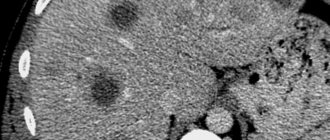Information about the disease
To find out how long people live with liver cirrhosis, it is necessary to become familiar with the features of this pathology. The presented disease is characterized by the death of hepatocytes and the formation of cirrhotic foci in the form of nodes. Gradually they increase in size and scar tissue forms between them.
In the early stages, healthy cells predominate, so the liver is able to cope with daily stress and compensate for diseased tissue. Because of this, there are no signs. Subsequently, the affected areas increase in size, which is why the gland does not fully perform its functions. Symptoms characteristic of cirrhosis appear. On average, the transition from early to late stages takes 3-4 years.
The pathology occurs predominantly in men over 40 years of age. In women, the disease is much less common, which is explained by a lower tendency to drink alcohol. In children, the lesion is diagnosed in exceptional cases. You can determine how long men with symptoms of liver cirrhosis live by taking into account their lifestyle.
The risk group also includes people suffering from diabetes mellitus, viral hepatitis and pathologies of the biliary system. The likelihood of developing a disease in a person increases if he has problems with excess weight or does not eat properly.
General forecast
Cirrhosis is an incurable disease. The changes occurring in the organ are irreversible. Gradually, the liver stops performing its functions, which causes complications. It is possible to increase life expectancy if the diagnosis is made in time, but this rarely happens due to the asymptomatic course of the pathology.
Attention! In the absence of treatment and non-compliance with healthy lifestyle standards, the patient reaches the terminal stage in an average of 4 years.
Speaking about how long people with liver cirrhosis live, it should be noted that at this phase, death cannot be prevented. The patient dies due to complications, failure of vital organs, or falling into a coma.
Medical statistics
Medical practice is rich in cases of relief from a serious condition and successful recovery. But dry facts speak for themselves better than words. The worst treatment results were for patients who led a chaotic lifestyle associated with alcohol and drugs. Life expectancy with associated complications is short. If you continue to drink alcohol, there is no talk of increasing the days of life. Death occurs suddenly.
The mortality rate for the third, most severe form of cirrhosis ranges from 60 to 90%. If the patient has survived inflammation of the peritoneum and lives, the probability of recurrence of peritonitis in the first six months is 50%. The more time passes, the higher the figure becomes and reaches 74%. The most common causes of death:
Bleeding or dysfunction of other organs of the excretory system can accelerate the death outcome in cirrhosis.
- Bleeding of internal organs. The mortality rate from the first bleeding ranges from 30 to 50%. Having survived, a relapse may occur and the figure reaches 70%.
- Organ functions are impaired (liver, kidney failure). In coma, death occurs in 100%. If the terminal form is complicated by failure of internal organs or the addition of oncology, the chances of recovery immediately decrease.
Return to contents
What determines the success of treatment
The effectiveness of therapy directly affects how long you can live with liver cirrhosis. At the moment, there are no drugs or other methods that can restore the affected areas of the gland. Treatment is aimed at improving the functions of healthy hepatocytes, normalizing metabolic processes and stopping the proliferation of fibrous tissue.
The effectiveness of therapy depends on the following factors:
- General condition and age of the patient.
- Stage and severity, intensity of symptoms.
- Origin of cirrhosis.
- Presence of complications.
- The nature of therapeutic procedures.
- Correct medication intake.
- Compliance with diet and daily routine.
- Bad habits of the patient.
It is difficult to determine with accuracy how long people live with liver cirrhosis, since the survival rate is individual for each clinical case. As a rule, forecasts are made based on the results of diagnosis and re-examination, which is carried out to improve the effectiveness of treatment.
Life expectancy with alcoholic cirrhosis of the liver
Alcoholism does not immediately damage hepatocytes. The gland produces enzymes that break down ethanol, which become insufficient over time. Adipose tissue containing alcoholic hyaline grows in the parenchyma. It can take five to twenty years for cirrhosis to develop. In women, hepatocytes are more sensitive to the effects of alcohol, and the disease occurs earlier. Features of the course of alcoholic cirrhosis.
- Deficiency of protein, vitamins.
- Neuromuscular disorders.
- Increased symptoms during binge drinking, improvement during refusal to take alcohol-containing substances.
- No complaints in the first period of cirrhosis.
- Enlarged salivary glands.
This is interesting: Differential diagnosis of liver cirrhosis
In such cases, cirrhosis of the liver can give five years - the maximum life expectancy. Stopping drinking ethanol will significantly prolong your life. In the absence of a damaging factor, the organ is able to work for a long time; the survival prognosis for this type of pathology is two times more favorable than for other types.
Difficulties in therapy
It is known that liver cells are restored. However, with cirrhotic lesions they are replaced by connective tissue, as a result of which regeneration becomes impossible. This is the main difficulty in therapy.
Another well-known problem of the disease is that it is impossible to identify the pathology at the initial stage, when there is a possibility of cure. Cirrhosis is diagnosed, most often, at stages 2 and 3, in which the organ has already undergone irreversible changes. In such cases, life expectancy can be increased only if the pathology is treated in time.
It is important to know! There are no effective medications or surgical procedures to reverse the pathology.
The treatment methods used are used to partially restore and maintain the functions of the gland. This directly determines how long people live with symptoms of liver cirrhosis.
Complications
Pathology leads to serious consequences. It is because of them that death occurs. In the terminal stage, the patients' condition is critical, which is why they are in intensive care. The complications that arise directly affect how long people live with a diagnosis of liver cirrhosis.
The most dangerous consequences of pathology include:
- Ascites (abdominal dropsy).
- Coma.
- Internal bleeding.
- Formation of oncology (hepatocellular carcinoma).
- Inflammation of the inner abdominal wall.
- Portal vein thrombosis (with cardiac form).
- Blood poisoning.
- Concomitant kidney damage.
The development of complications indicates that the disease is severe. They rarely live long in this condition. This indicates the need for timely provision of medical care.
Forecasts at different stages
How long people live with liver cirrhosis is directly affected by the stage of development of the disease. Therefore, during diagnosis, most procedures are aimed at determining the extent of the lesion. This allows not only to predict how long the patient has left to live, but also to determine the causes and methods of treatment that have a pronounced effect.
| Stage | Characteristic | average life expectancy |
| I | Represents the compensation stage. Liver damage is minor. The gland fully performs its functions. There are no signs of pathology. The small nodular form of the disease can only be detected through a thorough ultrasound examination. | In 50% of cases at least 7-10 years |
| II | Corresponds to the subcompensated stage of development. The first symptoms appear. Patients experience general malaise, nausea, and digestive disorders. In some cases, there may be pain in the right side. This indicates that the gland is no longer fully functional. | On average 5-6 years |
| III | Stage of decompensation. The liver cannot cope with the load, which causes a negative impact on other organs. Complications gradually form. Characteristic symptoms are bleeding, swelling of the extremities, jaundice, and short-term convulsions. | Maximum 3 years |
| IV | Terminal stage. The patient develops liver failure and encephalopathy. The patient, as a rule, remains in a coma. The gland becomes deformed and dies. | From several weeks to 1 year |
A common question is how long people live in the last stage of liver cirrhosis after transplantation. It should be noted that the transplant is performed in the 2nd or 3rd phase, since in the 4th phase the patient is in extremely serious condition and it seems impossible to operate on him.
A successful operation to replace the affected organ with a donor one is not a method of therapy that ensures a 100% recovery. This is due to the fact that the transplanted liver does not always take root. If the gland is not rejected, the life expectancy after transplantation ranges from 5 to 20 years or more.
How does treatment change survival outcomes?
After a series of diagnostic measures (laboratory tests, ultrasound, esophagogastroduodenoscopy, biopsy, scintigraphy, CT, etc.), therapy is prescribed. Specialists whose help may be needed: gastroenterologist, surgeon, hepatologist. For cirrhosis, complex therapy is indicated, including drug treatment, physiotherapy, surgery, diet and traditional medicine methods.
Drug effects
The selection of medications for cirrhosis should be carried out exclusively by a specialist, since only he is able to assess their compatibility, safety and effectiveness in specific situations.
List of medications prescribed for cirrhosis at different stages:
- hepatoprotectors (the need for the use of herbal preparations, essential phospholipids, ursodeoxycholic acid, lipotropic substances and vitamins for the liver is very acute, since these drugs allow the restoration of hepatocytes destroyed by the disease);
- immunostimulants;
- diuretics;
- drugs that eliminate nausea and vomiting;
- anti-itch medications (antihistamines);
- sedatives.
Cirrhosis cannot be treated without medication, as it eliminates unpleasant symptoms, prevents destructive processes in the organ and accelerates the healing process. Treatment is most effective at stages 1 and 2; at stages 3 and 4, medications are no longer able to cure the organ, but can significantly alleviate the patient’s condition and prolong his life
Surgical intervention
The radical treatment for cirrhosis is liver transplantation. This procedure is very complex and has a number of indications and contraindications. However, it gives the patient a chance to survive even at the last stage of the pathology.
In case of cirrhosis, doctors decide to perform a liver transplant if the patient has:
- internal bleeding that cannot be controlled with medication;
- ascites that cannot be treated;
- the following laboratory test results: a drop in the complex protein albumin (in cases where the mark falls below 30 g) and an increase in PTT (above 17 s).
Contraindications to the transplantation procedure (absolute):
- psychological and physical failure of the patient;
- the presence of an infectious process in the body;
- the presence of malignant neoplasms;
- AIDS
- decompensated cardiopulmonary pathology.
Also, transplantation for cirrhosis is not prescribed to patients if they have health problems such as inflammatory diseases of the brain, severe heart pathologies and obesity.
Physiotherapy
For cirrhosis, physiotherapy helps improve general condition, metabolism and maintain liver health. List of basic physiotherapeutic procedures:
- plasmapheresis is a blood sampling procedure that cleanses and returns it or some part of it back into the bloodstream;
Diathermy
ultrasound on the liver area is a technique that uses mechanical wave pulsation of microparticles of an ultrasonic medium;
- inductothermy is a method of physiotherapy, which is a treatment using a high-frequency magnetic field;
- diathermy is a procedure that uses heat generated by high-frequency alternating electric current;
- Iontophoresis is a type of hardware cosmetic procedure in which low voltage current plays the main role.
ethnoscience
Alternative medicine also offers recipes that can improve the prognosis of cirrhosis. The most effective of them can be considered the following:
- Infusion using milk thistle. It is recommended to mix a teaspoon of milk thistle seeds with a teaspoon of leaves of this medicinal plant, then pour boiling water (1 glass) over this mixture and let it brew for 20 minutes. Next, the resulting infusion must be filtered and drunk. Take daily, 3 times a day. You can also additionally drink tea made from mint, as it has a calming effect and enhances the effect of milk thistle infusion.
A decoction made from elecampane. To prepare this decoction, add 1.5 tablespoons of elecampane to the pan and add 500 ml of water. Next, put on low heat and cook for about half an hour. After this, you should infuse the product (approximately 20 minutes) and strain it. You can take the decoction no more than three times a day (200 ml each dose). The course of treatment is approximately 10 days.- Turmeric drink. To prepare it, you need to take a teaspoon of turmeric (powder) and pour a glass of boiled water (warm). Next, add honey and mix thoroughly. You need to drink this drink 2 times a day (no more than 200 ml per day).
- It is also recommended to drink juices from beets, white cabbage, black radish, potatoes and carrots.
In no case should we forget that traditional medicine for cirrhosis is not able to completely replace conservative treatment, so it can be used as an additional treatment for developing pathologies, as well as as a means for their prevention.
Nutrition
Proper nutrition can significantly improve the prognosis of many pathologies. In case of cirrhosis, it is imperative to follow a diet, since additional stress on the diseased organ can lead to rapid death. Therefore, it is worth knowing which foods and dishes can be consumed and which ones to exclude from the diet.
Products prohibited for cirrhosis:
- containing food additives and dyes;
- fried, salted, pickled and smoked dishes;
- sweets containing large amounts of fats and carbohydrates;
- animal fats, trans fats, meat and meat broths (from fatty varieties);
- dairy products with a high percentage of fat;
- certain vegetables such as legumes, radishes, garlic, onions, etc.;
- too sour fruits (berries);
- soda, tea and coffee.
The list of permitted and recommended products for cirrhosis looks like this:
- first courses without frying;
- meat and fish products (low-fat varieties);
- eggs (boiled, omelet, steamed);
- vegetable salads (vegetable oil should be used as a dressing);
- bakery products only made from wheat flour (preferably premium) and better dried;
- low-fat dairy and fermented milk products;
- Among sweets, jelly, jam, and marshmallows are allowed.
- compotes, juices, weak tea.
A complete list of permitted and prohibited foods for a specific type of cirrhosis is announced by a gastroenterologist during a consultation. He may also recommend reading literature that will help you diversify your menu without harming your health.
How long can you live
It is known that the survival rate depends on a wide range of factors. Unfortunately, it is impossible to accurately determine this indicator. A reliable prognosis can only be made by studying the individual clinical picture of the patient.
If the disease is detected early, the patient refuses to drink alcoholic beverages and switches to a diet - the likelihood of survival increases significantly. There are cases where, with careful therapy, the progression of the pathology was stopped, which allowed the person to lead a full life.
If the patient is an alcoholic, does not give up bad habits, or does not follow the doctor’s recommendations, the time is reduced. If untreated, the maximum survival time is a maximum of 5 years. In the overwhelming majority of cases, the patient lives 2-3 years before complications incompatible with life occur.
When cirrhosis is diagnosed, the question arises of how long one can live with such a diagnosis. A favorable prognosis is made exclusively at the initial stage. Late forms of the disease are accompanied by complications that provoke disruption of vital organs and gradually lead to death.
Prognosis of the disorder depending on the etiology
Depending on the etiology, the alcoholic and biliary (autoimmune) types of the disease are considered less complex. What is the life expectancy in such cases? If, with the alcoholic type, the patient stops drinking, the number of days allotted to him increases and reaches more than 5-6 years. With biliary disease, everything is not so optimistic; after the first signs appear, the patient has no more than 5.
There is a viral type of complication (viral hepatitis). This is the most difficult case in the treatment of cirrhosis with complications. The situation gets even worse when two types develop together: alcoholic and viral. There is no talk of a positive result in these cases; the result is quick death.









